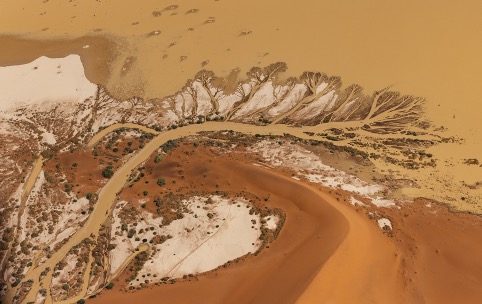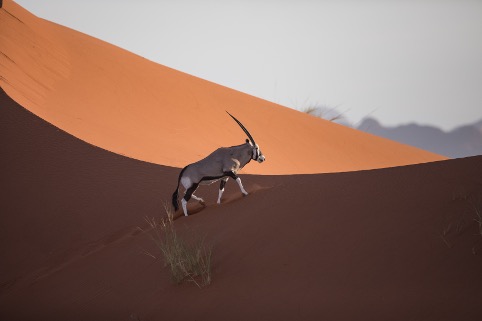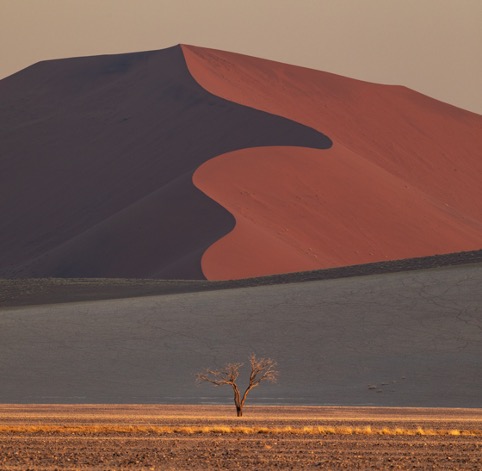The dramatic dunes of Sossusvlei are a must-visit in Namibia. But how to get pictures that you want to put up on your wall? Photographer Jandré Germishuizen explains how to approach photography at Sossusvlei.
Having spent the past 12 years of my life working in Namibian tourism, I have been fortunate enough to experience more than a few scenic wonders across this vast and open landscape. When you think of Namibia, your mind may drift to the iconic red dunes of Sossusvlei, a true photographic masterpiece carefully sculpted by Mother Nature herself.
Seeing Sossusvlei for the first time
I fondly recall my first visit to Sossusvlei, where all preconceived ideas surrounding the geography of the area quickly gave way to a much broader understanding of the landscape. I was amazed to see rolling valleys dressed in golden grass, gracefully framed by towering dunes in the distance. Ancient riverbeds revealed camel-thorn trees that had withstood the test of time. The vegetation in the area was a true testament to resilience, even in the harshest of conditions.
The valley narrowed as we travelled deeper down the sand track into the desert. With each passing minute the dune spines became more pronounced, revealing the breathtaking ripples in the sand. This was a place I instantly felt connected to. It continues to deliver on both a photographic and spiritual level, bringing new and enthralling scenery with each passing season.
At the epicentre of this desolate dune-scape we set our eyes on the infamous Deadvlei. It is a pristine landscape of burnt fossilised trees strewn across the pale clay pans of the desert. (This area is now synonymous with photography in Namibia.) This encounter marked the start of a decade spent living and working in Sossusvlei. Having fully immersed myself in the tourism industry I felt a strong desire to explore other parts of the country. Eventually I left my job at our family-run lodge and started my own tour company. It has enabled me to pursue my two greatest passions, travel and photography. Sossusvlei remains a top destination of mine, and I never tire of seeing its beauty.
Photo tips for Sossusvlei
Here are some tips to help you make the most of a visit to the area’s dunes and dried-up pans.
From above
If you have the opportunity to get in the air, do not hesitate as the area truly delivers on aerial images. Drones are strictly prohibited but there are daily sunrise and sunset flights by helicopter. Make sure to shoot with a high ISO to gain as fast a shutter speed as your camera can offer.
Pro tip: Remember to use lens stabilisation for aerial photography.

Textures
The grain and patterns of the dunes are a drawcard for any photographer. When shooting any texture of sand, gravel or clay make sure you are shooting straight down. This will help you achieve an ‘aerial photo’ aspect.
Weather
Weather conditions play a crucial role in capturing something different in a frequently photographed area. Sossusvlei is often plagued by heavy east winds. Resist the urge to pack away your camera as this is a great opportunity to take some mesmerising images.

Sossusvlei in flood is a natural rarity in the African landscape. When the rain touches the arid desert ground it opens up a new realm of photographic possibilities. These landscapes disappear at a rapid rate, leaving little room for indecision. You either commit to the trip or you miss out.
But the images you can capture depict extreme contrast, pairing dune belts with flowing bodies of water. Visually a dream for any photographer. When travelling in the summer be sure to gear up for warm conditions and muddy feet.

Travel tip: Once the Tsauchab River flows into the valleys of Sossusvlei it will take about a week before any travellers will be allowed to drive into the muddy roads.
Deadvlei
The iconic Deadvlei is the most photographed landscape in Africa. This incredibly diverse terrain that delivers standout portfolio images. As with any photographic hotspot there are a few tips to make your visit stand out. Where possible, spend a day scouting the Deadvlei area in search of compositions that interest you. Map the movement of the light at sunrise and sunset.
Deadvlei can receive up to a thousand visitors a day during peak season. Therefore early access to the park is imperative if you want to get memorable photographs. It is vital to be respectful towards other photographers so that everyone is able to obtain that special shot.

Pro tip: Take special care when photographing the trees. Be conscious of separating them to avoid branches touching. Try photographing from the base of the tree where the dunes and the pan meet.
The light changes drastically in the hour following sunrise, be sure to revisit certain compositions to see how the play of light has affected them.
Scale
A key photographic highlight for Namibia is the existence of scale and narrative, for both landscape and wildlife photography. Certain areas allow for clean lines and uncluttered surroundings. These locations lend themselves to a deeper understanding of the scale of the animal and the surrounding terrain.

Pro tip: A great photo tells a great story. Be on the lookout for an image that captures the essence and narrative of the area. The desert lends itself to this storytelling element by highlighting the unique adaptation of animals in a seemingly harsh and uninviting environment. Gemsbok and springbok roam the desert freely. With some clever manoeuvres, (as well as some key planning) you can get them to move across the dune crests.
Pattern
Our contrasting landscape can often be mistaken for a piece of art, highlighting a series of textures and patterns unique to Namibia. When photographing landscapes, I always look for areas that are almost abstract in appearance. My suggestion to fellow photographers would be to find a central element to anchor the photo (in this case, a tree). This allows the eye of the viewer to focus on a central point before exploring the additional elements of the image.

The alignment of the key element is completely subjective. Photography is not a set of rules that must be applied religiously, instead it is a form of art that should reflect the taste and style of the artist. In this instance the tree was perfectly aligned with the dune spine. The result? Creating a narrative of a majestic dune born from the remnants of an ancient tree. Again, the landscape tells a story of life, death and resilience.
Think about your photo with an added sense of emotion. What feeling will this image invoke in the viewer? Photos that have been taken purposefully and with intention will help you establish your identity as a photographer.
Last thoughts
Namibia is a truly untouched gem filled with a rich history and a feeling of old world simplicity. Untouched by the masses, it should be on every photographer’s bucket list. Through Go Gravel Photo Safaris, I lead photo tours to Namibia’s breathtaking landscapes. I never tire of the country’s visual magic.
For more photography by Jandré Germishuizen, follow @jandre_namibia_photo or @go_gravel_photosafaris on Instagram.
Travel tips for Sossusvlei
Sossusvlei is a World Heritage Site, part of the Namib Sand Sea. The ancient sand dunes are unspoilt, but the area is eco-sensitive. Unthinking tourists could have a massive impact on its pristine nature. Minimise your impact by following these guidelines:
- Keep to the main trails rather than wandering wherever through vegetation areas. Although the landscape may seem lifeless, many plants stay dormant until rain falls.
- The trees of Deadvlei are thought to date from around 900 years ago. Treat them as you would any museum piece. Do not sit or climb on them lest you damage a priceless artefact. Under no circumstances should you consider breaking off pieces of wood, whether for keepsakes or firewood.
- Limit the shifting of sand down the dunes by following in the tracks of others. Sliding or running down could take half the dune down with you.
Over to you
Have you captured the beauty of Sossusvlei on your overlanding travels? Send pictures to newsletter@tracks4africa.co.za for a chance to be featured in the Tracks4Africa newsletter.

